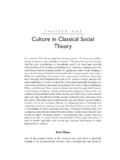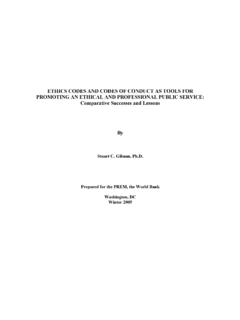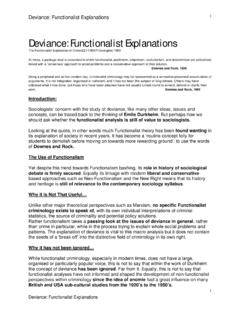Transcription of Religion as a cultural system - nideffer
1 Geertz, CliffordReligion as a cultural systemReaders are reminded that copyright subsists in this extract and the work from which it was taken. Except asprovided for by the terms of a rightsholder's licence or copyright law, no further copying, storage or distributionis permitted without the consent of the copyright author (or authors) of the Literary Work or Workscontained within the Licensed Material is or are the author(s) and may have moral rights in the work. TheLicensee shall not cause or permit the distortion, mutilation or other modification of, or other derogatorytreatment of, the work which would be prejudicial to the honour or reputation of the , Clifford, Religion as a cultural system .
2 In: The interpretation of cultures: selected essays, Geertz, Clifford, Fontana Press, is a digital version of copyright material made under licence from the rightsholder, and its accuracy cannot beguaranteed. Please refer to the original published for use at University of Oxford for the The Christian Doctrine of Creation course(s) running during theperiod 06/10/2003 to 05/10 (87-125)39433 Permission reference:ISN: Chapter 4/ReligionAs a cultural SystemAny attempt to speak without speaking any particularlanguage is not more hopeless than the attempt to havea Religion that shall be no Religion in Thus every living and healthy Religion has amarked idiosyncrasy.
3 Its power consists in its specialand surprising message and in the bias which that reve-lation gives to life. The vistas it opens and the mysteriesit propounds are another world to live in; and anotherworld to live in whether we expect ever to pass whollyover into it or no is what we mean by having a , Reason in ReligionITwo characteristics of anthropological work on Religion accomplishedsince the second world war strike me as curious when such work isplaced against that carried out just before and just after the first. One isthat it has made no theoretical advances of major importance.
4 It is liv-ing off the conceptual capital of its ancestors, adding very little, save acertain empirical enrichment, to it. The second is that it draws whatconcepts it does use from a very narrowly defined intellectual is Durkheim, Weber, Freud, or Malinowski, and in any particularwork the approach of one or two of these transcendent figures is fol-lowed, with but a few marginal corrections necessitated by the naturaltendency to excess of seminal minds or by the expanded body of reli-able descriptive data. But virtually no one even thinks of lookingelsewhere to philosophy, history, law, literature, or the "harder"88 THE INTERPRETATION OF CULTURES sciences as these men themselves looked, for analytical ideas.
5 And itoccurs to me, also, that these two curious characteristics are not the anthropological study of Religion is in fact in a state of generalstagnation, I doubt that it will be set going again by producing moreminor variations on classical theoretical themes. Yet one more meticu-louscase in point for such well-established propositions as that ancestorworship supports the jural authority of elders,that initiation rites aremeans for the establishment of sexual identity and adult status, that rit-ual groupings reflect political oppositions, or that myths provide char-ters for social institutions and rationalizations of social privilege, maywell finally convince a great many people, both inside the professionand out, that anthropologists are, like theologians, firmly dedicated toproving the indubitable.
6 In art, this solemn reduplication of the achieve-ments of acceptedmasters is called academicism; and I think this is theproper name for our malady also. Only if we abandon, in a phrase ofLeo Steinberg's, that sweetsense of accomplishment which comes fromparading habitual skills and address ourselves to problems sufficientlyunclarified as to make discovery possible, can we hope to achieve workwhich will not just reincarnate that of the great men of the first quarterof this century, but match way to do this is not to abandon the established traditions of so-cial anthropology in this field, but to widen them.
7 At least four of thecontributions of the men who, as I say, dominate our thought to thepoint of parochializing it Durkheim's discussion of the nature of thesacred,Weber's Verstehenden methodology, Freud's parallel betweenpersonal rituals and collective ones, and Malinowski's exploration of thedistinction between Religion and common sense seem to me inevitablestarting-points for any useful anthropological theory of Religion . Butthey are starting-points only. To move beyond them we must place themin a much broader context of contemporary thought than they, in and ofthemselves, encompass.
8 The dangers of such a procedure are obvious:arbitrary eclecticism, superficial theory-mongering, and sheer intellec-tual confusion. But I, at least, can see no other road of escape fromwhat, referring to anthropology more generally, Janowitz has called thedead hand of L. Steinberg, "The Eye Is Part of the Mind," Partisan Review 70 (1953) M. Janowitz. "Anthropology and the Social Sciences," Current Anthropology4(I963):I39, As a cultural System89In working toward such an expansion of the conceptual envelope inwhich our studies take place, one can, of course, move in a great num-ber of directions; and perhaps the most important initial problem is toavoid setting out, like Stephen Leacock's mountedpoliceman, in all ofthem at once.
9 For my pan, I shall confine my effort to developing what,following Parsons and Shils, I refer to as the cultural dimension of reli-gious The term "culture" has by now acquired a certain auraof ill-repute in social anthropological circles because of the multiplicityof its referents and the studied vagueness with which it has all too oftenbeen invoked. (Though why it should suffer more for these reasons than"social structure" or "personality" is something I do not entirely under-stand.) In any case, the culture concept to which I adhere has neithermultiple referents nor, so far as I can see, any unusual ambiguity: it de-notes an historically transmitted pattern of meanings embodied in sym-bols, a system of inherited conceptions expressed in symbolic forms bymeans of which men communicate, perpetuate, and develop theirknowledge about and attitudes toward life.
10 Of course, terms such as"meaning," "symbol," and "conception" cry out for explication. Butthat is precisely where the widening, the broadening, and the expandingcome in. If Langer is right that "the concept of meaning, in all its varie-ties, is the dominant philosophical concept of our time," that "sign,symbol, denotation, signification, communication .. are our (intellec-tual] stock in trade," it is perhapstime that social anthropology, andparticularly that part of it concerned with the study of Religion , becameaware of the we are to deal with meaning, let us begin with a paradigm:viz.)








